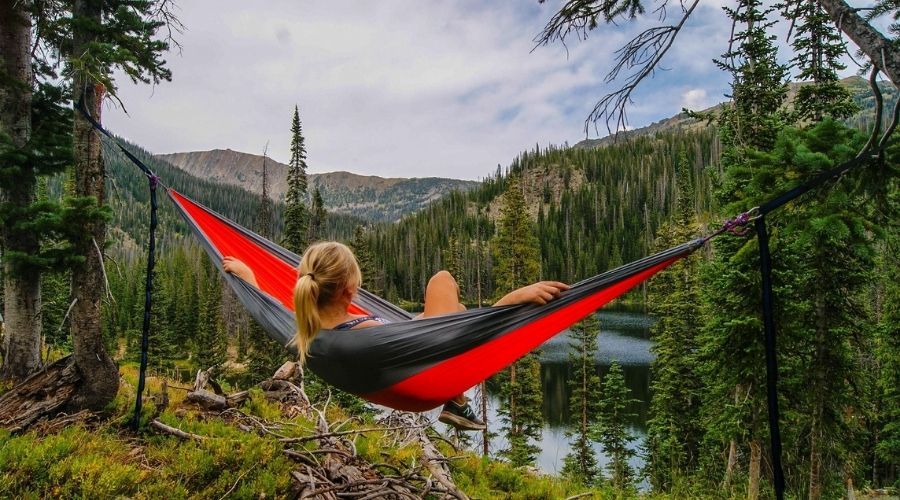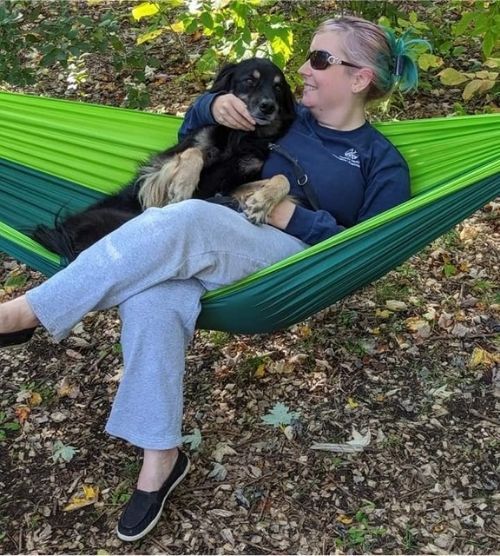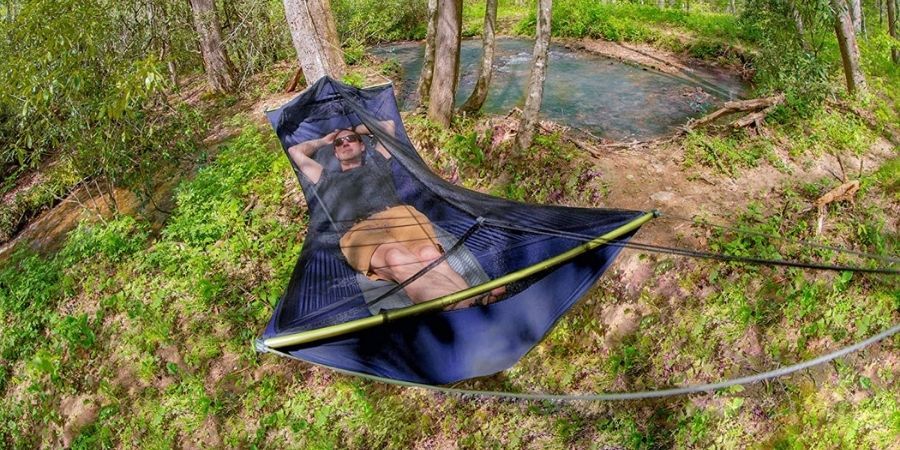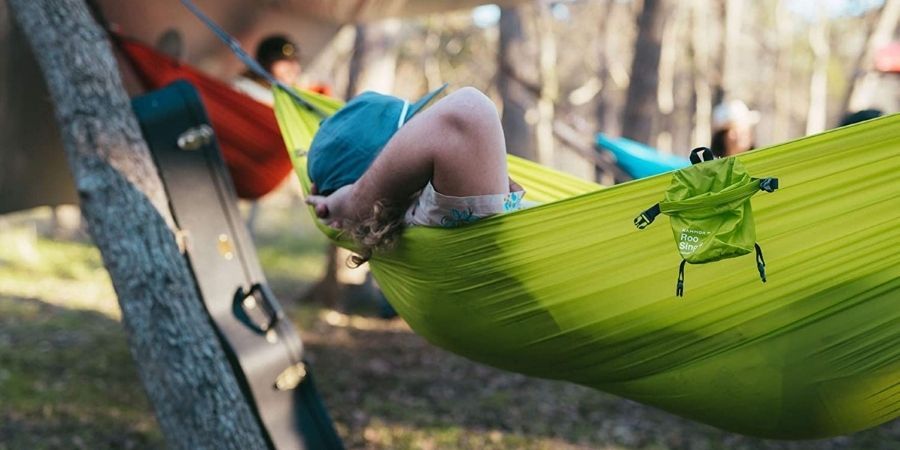Hammock camping is quickly gaining popularity in the outdoor travel community as people realize that it’s not only convenient but also a comfortable way to camp. Whether you’re backpacking through crownland with only the gear on your back or car camping with the family, there are comfortable, easy to set up and affordable options available.
The secret to a successful hammock camping trip is to determine which hammock style is best suited for your needs. This includes the features that you require as well as your own personal comfort. We have taken the time to search for the best camping hammock for every situation.
The Backyard Boss Top Camping Hammock for Summer 2021
|
PRODUCT |
FEATURES |
||
|---|---|---|---|
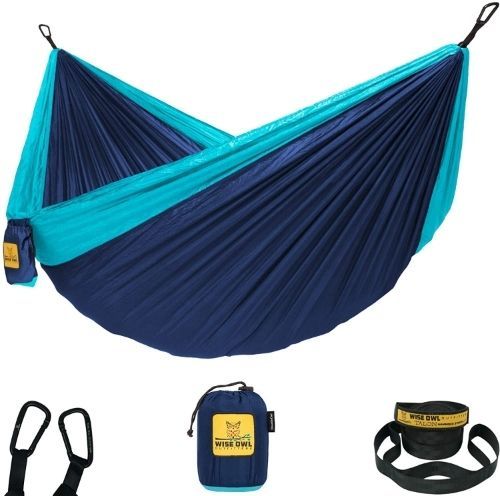
|
|
||
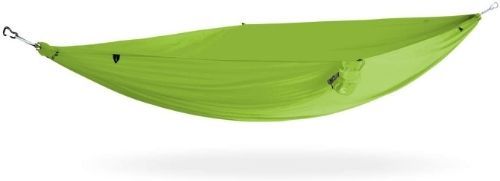
|
|
||
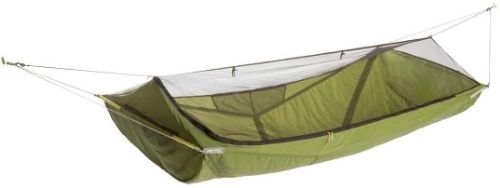
|
|
||

|
|
||
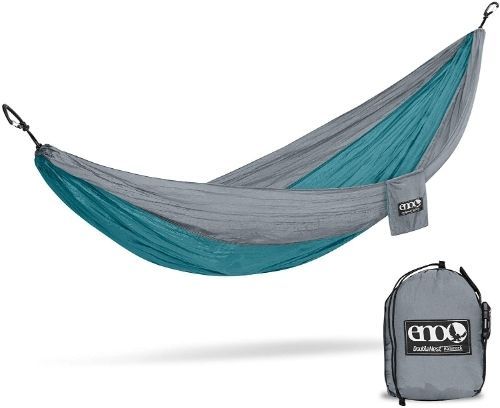
|
|
Why You Can Trust Us
At Backyard Boss, we have a love for outdoor activities. We are always looking for different opportunities to get outside and enjoy the fresh air, whether it’s working in our garden, hanging out in our backyard, or venturing further on an outdoor travel adventure.
Personally, my husband and I are happiest when we are spending our time hiking and camping with our two dogs. We have accumulated a large collection of different camping supplies and options depending on how we are feeling at the time, including several different hammocks both to enjoy in our backyard as well as at the campsite.
My first hammock was a gift from my brother, but he had no idea that he was responsible for a new passion. Since that time, I have purchased hammocks, hanging straps, under quilts, rain tarps, hammock stands, and more. Some of these items have fallen short of my expectations while others have surprised me with their comfort and versatility.
Each of the options listed in this article has been researched and reviewed for their durability, comfort level, size (for travel), and value. My goal is to help you find a hammock that both fits your budget and provides all of the features that you need for your outdoor travel style.
Best Overall Hammock
This lightweight and compact parachute-style hammock is a durable option at a surprisingly low cost.
- Low cost
- Includes 9-foot tree hanging straps
- Packs away in small stuff sack for easy transport
- No bug netting or rain fly included
- Narrower design may not be as comfortable for taller campers
|
|
Why We Like It: Don’t allow the low price of the Wise Owl Outfitters Hammock to fool you. This parachute-style hammock is made from high-quality parachute nylon and thread lock stitching to ensure that it will stand up to regular use. It also comes with two nine-foot Talon Straps, allowing you to suspend the hammock between two trees quickly and easily.
This hammock packs up into a small and easy to carry stuff sack, making it another great option for travel when camping, visiting the beach, or just hanging out at the park for the day. In addition to the gear included in the base price, the company does also offers a sleeping pad, rain tarp, bug net, and foam pillow that can all be added to the hammock when needed.
The single hammock featured here is nine feet long, however, with the traditional gathered end design, some taller campers have found that it isn’t as comfortable. You can, however, upgrade to a 10-foot double hammock for the extra room.
Who Should Buy It: Whether you’re new to hammock camping and not ready to invest until you have had a chance to try it out, or simply want to keep the cost down, this is a great option at a low price.
Best for Backpacking
This ultra portable and durable waterproof hammock sets up in less than 60 seconds and packs away into a pocket-sized stuff sack.
- Water repellent
- Ultralight design to minimize extra gear weight
- Lifetime warranty
- No hanging straps included
- No bug netting or rain tarp included
|
|
Why We Like It: This small hammock may not look like anything special, however, the durable Gravitas nylon fabric and Mini Kanga Claw patented carabiners are designed to support up to 5,000 pounds of force and can handle a weight capacity of 400 pounds. The best part for backpackers is that all this packs away into a small pocket-sized stuff sack that weighs only 0.64 pounds.
The hammock itself is breathable for even the hottest days and water-resistant to prevent condensation during the cooler seasons. While it doesn’t include a rainfly, you can easily use a tarp to cover the top, if necessary, during questionable weather. Attached to the hammock are eight reinforced gear loops to make it easier to attach accessories or to hang your gear, like a water bottle, close at hand.
Who Should Buy It: If you are planning to do backcountry camping or are limited on space, this is a great option in a small package.
Best for Sleeping
This bridge-style hammock provides a flat surface for sleeping that can also hold a sleeping mat for additional comfort.
- Includes integrated bug net
- DAC spreader bar system holds hammock flat
- Does not include pictured suspension system
- Bug net can’t be removed entirely
|
|
Why We Like It: Unlike a traditional hammock, the lay-flat or "bridge" style of hammock of this hammock creates a comfortable cot-like sleeping experience. When not in use, the DAC Spreader Bar system can be removed, allowing you to pack it away easily in a smaller space. This design makes it comfortable for back sleepers and those who prefer side-sleeping.
If you are looking for a little extra comfort, a standard sleeping pad can easily be added to the hammock as an extra layer. The more open style of this hammock is also a great option for those that may feel constricted in a traditional hammock.
The only downfall with this style of hammock is that there is additional gear required, such as the spreader bar. However, if you have the extra space, it is a great option for a comfortable sleep.
Who Should Buy It: Campers that are looking to enjoy the hammock experience without sacrificing comfort may find that the SkyLite Hammock is their best option.
Best Camping Hammock Tent
An incredibly versatile option, this hammock can be used as a comfortable bridge-style hammock with a sleeping pad for extra comfort or set up on the ground as a bivy tent.
- Arch pole/spreader bar system for improved comfort
- Includes bug netting and detachable waterproof rainfly
- Can also be used as a bivy tent
- No hanging straps included
- Bug netting can not be entirely removed
|
|
Why We Like It: This is an incredibly versatile camping hammock tent that can be used as a suspended bridge hammock, a hammock tent with the waterproof rainfly, or a bivy tent on the ground. If you are considered that you may be camping somewhere that may not offer the trees needed to suspend your hammock, this flexibility will make sure that you have a comfortable and dry place to sleep. The Blue Ridge Camping Hammock is a lay-flat design, making it easy to add a sleeping pad for additional comfort at night.
While this hammock does not come with hanging straps, it does include integrated mosquito netting and a removable waterproof full-coverage rainfly that attaches directly to the hammock itself with no need for additional staking. The ceiling of the tent has two O-rings, allowing you to hang a reading light or other lightweight gear.
Who Should Buy It: The Blue Ridge Camping Hammock is a great option for anyone that is heading out to camp in an area where they may be faced with questionable weather, unpredictable landscapes, or pesky bugs.
Best Two-Person Hammock
Lightweight and comfortable for two people, this hammock makes it easy to relax together as a couple without adding too much gear to your packing list.
- Wider design provides space for two people comfortably
- Breathable, quick-drying nylon
- Packs away in small stuff sack for easy transport
- Hanging straps not included
- No bug net or rainfly included
|
|
Why We Like It: While the other hammocks on this list are designed with a single person in mind, the DoubleNest Hammock is wider in design (measuring six foot two inches wide) allowing for two people to comfortably lounge together. Alternatively, it offers extra space for the solo camper that is looking to stretch out and relax.
This hammock has been made using durable high tenacity nylon taffeta which can support up to 400 pounds comfortably. While it is not waterproof or water-resistant, it is quick-drying. It is also a highly breathable material, preventing you from getting too warm on a hot summer day.
Traditional in design, this parachute-style tent packs up in a small stuff sack, making it easy to transport. While it doesn’t come with any additional gear, Eagle Nest Outfitters does make and offer hanging straps, bug nets, and rain tarps that can be used with it when needed.
Who Should Buy It: For those that enjoy camping with a friend or partner and hanging out together, this lightweight two-person hammock is a great option.
How to Enjoy Your Next Hammock Camping Adventure
While most new campers start by sleeping in a tent or travel trailer, those that experiment with camping hammocks quickly discover that they are an affordable and super comfortable sleeping option that require less time and effort to set up than the average tent. If you’re tight on space, they are also significantly smaller, tucking away in the corner of your hiking pack until they are needed.
However, not all hammock camping experiences are a success. To ensure that you are secure and comfortable throughout the night, you need to purchase reliable gear AND know how to use it.
How to Hang a Hammock
Most hammock campers hang their hammocks by suspending them between two trees. This is the preferred method simply because it doesn’t require any bulky gear and doesn’t damage the trees. It may seem like a very easy and basic concept but hanging your hammock incorrectly can make for a very uncomfortable night or even lead to a serious injury.
If your hammock is suspended with too much tension, it won’t have the give needed for you to get comfortable, causing unnecessary aches and pains. In some cases, it may even lead to your hammock tearing leaving you with no other option than to sleep on the ground.
On the other hand, a hammock that is too loose isn’t going to provide the support that you need. This will lead to you sleeping in a curved position which can cause significant back pain. This is a mistake that you will make once and never make again (trust me).
Step 1: Find a Hanging Spot
Choose two trees that are approximately 10 to 15 feet apart, depending on the length of your hammock.
If you are car camping and don’t have two ideal trees available, you can use a solid roof rack on your vehicle to hang one side. Make sure to look at the roof rack’s weight limit to be sure that it can support your weight safely.
Alternatively, if you have the extra packing space and you want to be sure that you will be able to suspend your hammock securely, you may want to bring a hammock stand. This would allow you to enjoy your hammock regardless of your surroundings. They come in many different designs and sizes, with some created to pack up in a bag similar to a tent to travel with you to wherever they are needed.
Step 2: Secure Your Hanging Straps
The easiest option for suspending your hammock is a hanging strap, however, you can also tie it up using a basic rope. Secure your rope or hanging strap at least four feet up the tree to create a 30-degree angle when your hammock is hanging. This will give you the tension needed to create a flat and comfortable sleeping space without going overboard.
Choosing the Right Hammock
Single vs. Double Hammocks
The most basic size-related decision that you will need to make is whether you are looking for a single or double hammock. On the surface, this may look like an easy choice. A single hammock is obviously designed for a single person while a double is designed to accommodate the additional space and weight needed for two people. However, if you are a taller person like my husband or simply prefer to have more room to spread out when you are sleeping, you may find that you are more comfortable sleeping in a double hammock.
There are some manufacturers that offer XL hammocks designed to hold a whole family, however, these aren’t as common as the basic single and double options.
Carrying Capacity and Width
Looking at the size of your hammock in a little more detail, you want to consider the max weight capacity that your hammock can hold as well as the width of the hammock itself. Many of the ultralight hammocks designed for backpacking are narrower with a lighter maximum weight as this allows them to reduce the material required, lowering the overall weight and size of the hammock during travel.
If you are camping with pets or children, you also want to consider their weight in this assessment. As I previously mentioned, my dogs are almost always with us when we’re traveling. They both enjoy spending time snuggling up in the hammock. For this reason, I choose hammocks with a higher weight capacity so that they can accommodate my weight and theirs.
Many hammock campers that are using traditional-style hammocks with the gathered ends find it more comfortable to sleep diagonally in the hammock to create a flatter sleeping area. If you fall into that category, you are going to want to search for a hammock with the additional width to accommodate that.
Image credits: ENO via Amazon
Fabrics and Materials
There are many different styles of hammock available today including a wide variety of different fabrics and materials. Each of these styles is designed with a different purpose in mind. For example, the more traditional rope hammocks are great for lounging, however, they are not the most comfortable for sleeping in and the cotton ropes absorb moisture. They are a great option for the backyard but aren’t ideal for hammock camping.
Cotton hammocks are often very comfortable for sleeping, making them a popular option for backyard hammock napping. While they can work for a camping trip, the cotton material will only work for optimal weather conditions.
The most common material used for camping hammocks is nylon due to the fact that it’s quick-drying, breathable, lightweight, and resistant to rot, mold, and mildew. However, many manufacturers are using woven materials to create hammocks that are more breathable, more durable, or warmer for cooler temperatures. For example, Mayan hammocks are made from woven nylon and cotton, creating a breathable hammock for the hotter summer months.
Hammock Styles
There are three main styles to consider when purchasing a camping hammock.
The first, the hammock chair, is obviously not for overnight use. These chair-like hammocks don’t allow you to lay down, however, they are a great option for lounging comfortably. Car campers can purchase a special hitch attachment that will suspend two hammock chairs from the back of the vehicle.
Traditional hammocks are a simple curved design with the end of the hammock gathered before being attached to some sort of suspension option. To sleep comfortably in a traditional hammock, most campers find that they need to lay on a diagonal in order to avoid having the curve lifting their legs in an uncomfortable position. They are generally lighter weight for travel but can be uncomfortable for sleeping if you aren’t familiar with how to position yourself or if the hammock doesn’t allow you to create that flat sleeping surface.
Lay-flat or Bridge-style hammocks use a suspension bar system to hold the hammock flat for you in the middle. If you are a side-sleeper or stomach-sleeper, this is a necessity. While back-sleepers can get comfortable in a traditional hammock, the lay-flat style doesn’t require them to position their body specifically to make it happen. This style also makes it easier to use a sleeping pad as it doesn’t curl up.
Hammock Camping Gear
Stuff Sack
A stuff sack is a small bag that your hammock will go into. It is referred to as a "stuff sack" as you should physically stuff the hammock in rather than rolling or folding it. This means that you aren’t putting pressure on the same fold lines repeatedly, damaging the material over time. They can come as a separate piece of gear with your hammock or attached to the side of the hammock as is often seen on parachute-style hammocks.
Hanging Straps and Suspension Systems
There are a variety of different hanging straps and suspension systems. Daisy Chains are the east option for beginners. They are thin straps that wrap around the tree and offer a series of loops to attach your hammock to using steel carabiners.
Tree straps are simple straps that require a single knot to attach your hammock to the strap. These are the most common hanging straps and are the option that is often included with a hammock at purchase. The strap wraps around the tree and then is secured to your hammock using a single knot on the carabiner.
Additional and more complicated suspension systems are often used by manufacturers for lay-flat hammocks to accommodate the spreader bars and maintain the flat surface. These are often unique to the manufacturer of the hammock itself.
Spreader Bars
Spreader bars are metal or wooden bars that hold the hammock so that it spreads out the fabric to create a flat surface. Some options are permanently attached to the hammock while others can be removed and disassembled to make them smaller for travel.
Image credits: Kammok via Amazon
Tent, Cover, or Rain Fly
There are a wide variety of hammock tarps and rain fly products available to protect you from the weather throughout the night. While you can use a basic blue tarp from your local hardware store, they are bulkier and more challenging to hang effectively.
Many brands will offer a rain fly option that is specific to your model of hammock specifically. However, if you are familiar with the shape and sizing of your hammock, you can explore other third-party options that are on the market.
A rainfly may attach directly to your hammock, be suspended between the trees above your hammock separately from the hammock itself and/or be staked down to the ground on either side of the hammock. They are designed to withstand wind and rain, giving you a safe, dry and comfortable place regardless of what the weather decides to do.
Bug Netting
If you have ever camped in an area with mosquitoes or black flies, then you know why a bug net is an important consideration. No one wants to wake up in the middle of the night covered in itchy bug bites! While some camping hammocks will come with a built-in bug netting system, you can purchase bug netting systems that will work with any standard hammock to keep you safe and protected.
Sleeping Pad and Sleeping Bag
For those that are planning on sleeping in their hammock, bedding is an important consideration. Some campers prefer to use a standard sleeping bag simply due to the ease of use, while others are more comfortable using blankets and sheets, folded to allow for bedding both above and below your body (as the cool night breeze will circulate on both sides.
Lay-flat style hammocks easily accommodate a standard camp sleeping pad to add a little extra cushion to your sleep. If you are camping with a traditional hammock, you may choose to add a sleeping pad however there is the risk that it will shift and move out of the hammock throughout the night. Sleeping pads with smaller individual pockets of air generally bend better to accommodate the curve of a traditional hammock. Alternatively, some brands will sell sleeping pads specifically designed for their hammocks.
Some hammocks are built with walls to keep your sleeping pad in place. Others offer a double-layered system where your sleeping pad slides in between the layers where it will stay securely even if you are moving throughout the night.
Under Quilt
Finally, if you are planning on camping during cooler fall/spring temperatures or braving the cold of winter, you will need to consider additional insulation. An under quilt looks like a bulky sleeping bag that hangs outside of your hammock, adding an extra layer between you and the cold air beneath you. These are highly effective however they do take a lot of room when packing.
How We Picked
For this roundup, we looked at the various styles of hammock camping ranging from casual day use as a lounge option up to overnight camping adventures in unpredictable weather. In addition to relying on our own experience with the various hammocks on the market, we also looked at different user reviews as well as the basic features that each hammock offered.
This left us a list of great hammocks to consider from trusted outdoor travel brands. From there, we looked at several factors to narrow our list further including the quality, usability, and level of comfort that they offer. After all, no one wants to spend time in an uncomfortable hammock!
In the end, we put together a list that highlighted the best of the best for each camping style and setting.
Which Camping Hammock Is the Best for Your Next Trip?
With so many great camping hammocks currently available, there is an option for every style of camper. The key to choosing the best hammock for you and your lifestyle is to first look at your plans and what features you need for a comfortable and enjoyable trip. You may need to sacrifice some of the bells and whistles for a compact and lightweight hammock when backpacking, or you may wish to purchase some of the available gear options for a luxury set-up.
Our overall favorite hammock was the Wise Owl Outfitters Hammock. This low-cost hammock was able to hold a surprising 500 pounds while still packing up in a small and easy-to-carry stuff sack. We also loved that it came with all the necessary gear to hang your hammock, preventing newer hammock users from forgetting something important. For the average camper, this hammock covers all of the basic needs.

